JunkScience.com
January 15, 2005
Supplemented January 26, 2005
Notice of relocated data source June 3, 2005
Once again claims are flying thick and fast regarding dramatic, in fact, unprecedented Arctic warming.
Once again, we look at the available data, now updated to the end of 2004.
Once again, we find the claims to be dead flat wrong. Click on the following thumbnails to view the full size images in a new browser window.
Note: subsequent to NASA's server upgrade the correct URL for zonal temperature anomalies is: http://data.giss.nasa.gov/gistemp/tabledata/ZonAnn.Ts.txt
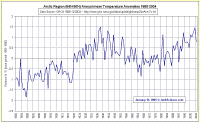 We begin, as is our want, with the bare annual mean temperature track for the region 64N-90N. We use this particular dataset since the Arctic Circle describes a line of latitude near but south of the north pole marking the northernmost point at which the sun is visible on the northern winter solstice and the southernmost point at which the midnight sun can be seen on the northern summer solstice - roughly the parallel of latitude approximately 66°33' north and we are thus confident of having captured the boundary between the North Temperate and North Frigid zones.
We begin, as is our want, with the bare annual mean temperature track for the region 64N-90N. We use this particular dataset since the Arctic Circle describes a line of latitude near but south of the north pole marking the northernmost point at which the sun is visible on the northern winter solstice and the southernmost point at which the midnight sun can be seen on the northern summer solstice - roughly the parallel of latitude approximately 66°33' north and we are thus confident of having captured the boundary between the North Temperate and North Frigid zones.
Rather obviously it indicates a sustained warming, followed by a cooling and recovery.
 Of course, some people want (and others need) rather more aggressive highlighting of apparent trends and so we present the same data with shading and trend lines added. This next graphic shows the very same data with split trends and shading to highlight the warming trend 1880 through 1938 (the warmest year in the series). Had the pre-1938 trend continued there would certainly be some Arctic warming to talk about. Just as well we are not staunch advocates of post hoc, ergo propter hoc or we'd be claiming that increasing the rate of atmospheric CO2 increment stops Arctic warming.
Of course, some people want (and others need) rather more aggressive highlighting of apparent trends and so we present the same data with shading and trend lines added. This next graphic shows the very same data with split trends and shading to highlight the warming trend 1880 through 1938 (the warmest year in the series). Had the pre-1938 trend continued there would certainly be some Arctic warming to talk about. Just as well we are not staunch advocates of post hoc, ergo propter hoc or we'd be claiming that increasing the rate of atmospheric CO2 increment stops Arctic warming.
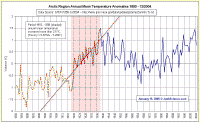 We would be remiss if we did not point out the most significant warming in the series.
We would be remiss if we did not point out the most significant warming in the series.
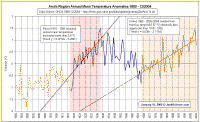 And now, trends 1918-1938 and 1966-2003 compared (yes, we know data is available in the series to include 2004 but the region's annual mean temperature fell two-thirds of one degree C from the partial series maximum value of 2003).
And now, trends 1918-1938 and 1966-2003 compared (yes, we know data is available in the series to include 2004 but the region's annual mean temperature fell two-thirds of one degree C from the partial series maximum value of 2003).
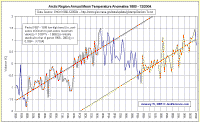 Finally, let's look at the low-high trend values for the warming periods before and after the cooling demonstrated 1938 - 1966.
Finally, let's look at the low-high trend values for the warming periods before and after the cooling demonstrated 1938 - 1966.
In other words, we'll consider three decades of cooling an anomaly in the series and take a longer perspective - how has the Arctic recovery from the Little Ice Age varied over roughly one hundred and twenty years?
The answer is, it hasn't. The post-LIA recovery seems to be trundling along the same as before, despite an Earth-insignificant setback of a few decades in between. The last 3-4 decades are not the fastest warming period of the series nor the slowest, rather, with the longer-term perspective they appear very ordinary.
So, according to data from the Global Historical Climatology Network (GHCN), from this file hosted by NASA's Goddard Institute for Space Studies (GISS), there has been no net Arctic warming since 1938, the Arctic did warm quite abruptly over the two decades prior to that, has subsequently cooled and (nearly) recovered to what it was before being so rudely interrupted.
Beyond all doubt atmospheric carbon dioxide content has increased over the period, mainly from about the time the Arctic shifted to cooling mode for a spell. That trace gas increase has had no apparent effect on the Arctic's post-LIA warming.
Since the rate of warming is unchanged and the net Arctic temperature has not increased in almost 7 decades it is very difficult to see what all the hysteria is about.
Supplemental, January 26, 2005:
It's becoming fashionable to claim rapid Antarctic warming too - from NYT yesterday:
"Antarctica, Warming, Looks Ever More Vulnerable" - "A continent is quickly changing. The questions are how and why." (New York Times)
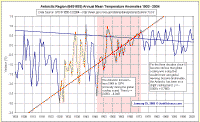 Antarctica, however, is not warming. While the enhanced greenhouse hypothesis insists the Antarctic should demonstrate the most dramatic response to rising atmospheric carbon dioxide levels due to its cold, dry atmosphere, the simple fact is the Antarctic is not cooperating.
Antarctica, however, is not warming. While the enhanced greenhouse hypothesis insists the Antarctic should demonstrate the most dramatic response to rising atmospheric carbon dioxide levels due to its cold, dry atmosphere, the simple fact is the Antarctic is not cooperating.
South Polar air samples record atmospheric CO2 rising from 328 ppmv to 373 ppmv subsequent to the 1949-1974 temperature increase - almost 15% increase apparently without affecting Polar temperatures, while startling temperature changes of ~4 °C (+ve and -ve) are recorded in periods when we know atmospheric CO2 was increasing at a more leisurely rate.
A treasured hypothesis insists increasing atmospheric CO2 should lead to increasing temperature and the South Polar super-cold, super-dry air mass should respond dramatically. Well, we looked for the CO2 increment and it is obvious. We looked for the temperature increment and... what? Found it missing? There it was, gone?
We've already had the "you could see the warming if it wasn't being hidden by the cooling (which is being hidden by the warming)" thing - see "Stratospheric Cooling?" What is Big Warming going to come up with now - "Please Miss, the ozone hole ate my Antarctic warming"?
Home
Copyright © 2004-2005 JunkScience.com - All Rights Reserved.
This article, including graphics, may be reprinted in full or in part with attribution.
![]()